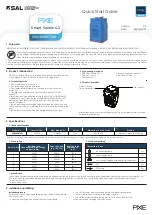
52 - RocketLinx ES7528 Industrial Managed PoE Rack Mount User Guide
: 2000509 Rev. A
Port Trunking
Port Trunking
Port Trunking
Port Trunking configuration allows you to group multiple Ethernet ports in parallel to increase link bandwidth. The aggregated
ports can be viewed as one physical port so that the bandwidth is higher than merely one single Ethernet port.The member
ports of the same trunk group can balance the loading and backup for each other. The Port Trunking feature is usually used
when you need higher bandwidth for the network backbone. This is an inexpensive way for you to transfer more data.
There are some different descriptions for the port trunking. Different manufacturers may use different descriptions for their
products, like Link Aggregation Group (LAG), Link Aggregation Control Protocol, Ethernet Trunk, or Ether Channel.
The aggregated ports can interconnect to the other switch, which also supports Port Trunking. Comtrol supports two types of
port trunking:
•
Static Trunk
•
802.3ad
When the other end uses 802.3ad LACP, you should assign 802.3ad LACP to the trunk. When the other end uses non-802.3ad,
you can then use Static Trunk.
There are two pages for port trunking, Aggregation Setting and Aggregation Status.
Aggregation Setting
Aggregation Setting
Description
Trunk Size
The switch can support up to 8 trunk groups. Each trunk group can support up to 8 member
ports. Since the member ports should use the same speed/duplex, maximum groups for 100M
ports would be 7, and 3 for gigabit ports.
Group ID
Group ID is the ID for the port trunking group. Ports with same group ID are in the same group.
Trunk Type
Static or 802.3ad LACP. Each Trunk Group can only support Static or 802.3ad LACP. Choose
the type you need here. Non-active ports cannot be setup here.
Load Balance Type
There are several load balance types based on dst-ip (Destination IP), dst-mac (Destination
MAC), src-dst-ip (Source and Destination IP), src-dst-mac (Source and Destination MAC), src-
ip (Source IP), src-mac (Source MAC).
















































